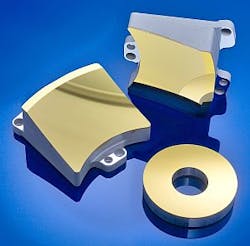REO diamond-turned aspheres available in all aspheric profiles

A range of diamond-turned aspheres fabricated from either aluminum or copper substrates are produceable in sizes up to 300 mm, with any aspheric profile. Available metallic and dielectric enhanced metallic coatings include gold, solderable gold, protected silver, aluminum, and enhanced aluminum. Applications include infrared (IR) imaging and military target designation systems operating in the mid-IR (3–5 µm) or thermal imaging (12 µm) bands.
REO
Boulder, CO
www.reoinc.com
More Products
-----
PRESS RELEASE
REO Supplies Diamond Turned Aspheres in High Volume
REO, a leading manufacturer of high volume precision optical solutions, now offers a range of diamond turned, aspheric mirrors, including off-axis parabolas, fabricated from either aluminum or copper substrates. These mirrors can be produced in sizes up to 12 inches (300 mm), with virtually any aspheric profile, including both rotationally and non-rotationally symmetric (e.g. cylindrically aspheric and toroidal) curves. REO’s state of the art testing and fabrication protocols ensure extremely accurate figure (surface form) for these products, with sag deviation accuracies as low as ½ fringe. These reflective optics are available with a choice of various metallic and dielectric enhanced metallic coatings, such as gold, solderable gold, protected silver, aluminum and enhanced aluminum. Furthermore, REO can produce these thin films using traditional evaporative methods, as well as ion beam sputtering (IBS), the latter technique generally delivering denser and more environmentally stable coatings. In addition, REO’s vertically integrated fabrication capabilities, together with the company’s large coating capacity, enable them to support high production volumes with industry leading cycle times.
Aspheric metal mirrors, and especially off-axis parabolas, are often used in infrared imaging and military target designation systems typically operating in the mid-IR (3 – 5 µm) or thermal imaging (12 µm) bands. In these applications, they allow designers to reduce total component count and diameter, thus offering savings in both cost and package size. Moreover, REO can readily produce mechanical mounting features directly on the part that are registered to the optical surface with a high degree of precision. Integrating mounting functionality within the part also helps reduces package size, and even enables these optics to be dropped into assemblies with minimal additional optical alignment, thus further reducing production costs and cycle times for the system integrator.
About REO
REO produces high precision thin film coatings, optics and opto-mechanical assemblies for the ultraviolet, visible and infrared. Located in Boulder, CO, the company primarily services medium to high volume OEMs including manufacturers of defense and aerospace systems, laser systems, semiconductor tools, medical systems, life sciences instrumentation and telecom equipment. REO is a privately held company. For more information, contact Mark Damery, Vice President and General Manager of Worldwide Sales, at +1-720-562-3213, e-mail [email protected], www.reoinc.com, or Susan Anway, Vice President of Finance and Chief Financial Officer at +1-720-562-3206, e-mail [email protected].
-----
Follow us on Twitter
Subscribe now to Laser Focus World magazine; it's free!